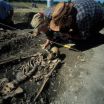(Press-News.org) CAMBRIDGE, Mass-- The smallest, most abundant marine microbe, Prochlorococcus, is a photosynthetic bacteria species essential to the marine ecosystem. An estimated billion billion billion of the single-cell creatures live in the oceans, forming the base of the marine food chain and occupying a range of ecological niches based on temperature, light and chemical preferences, and interactions with other species. But the full extent and characteristics of diversity within this single species remains a puzzle.
To probe this question, scientists in MIT's Department of Civil and Environmental Engineering (CEE) recently performed a cell-by-cell genomic analysis on a wild population of Prochlorococcus living in a milliliter — less than a quarter teaspoon — of ocean water, and found hundreds of distinct genetic subpopulations.
Each subpopulation in those few drops of water is characterized by a set of core gene alleles linked to a few flexible genes — a combination the MIT scientists call the "genomic backbone" — that endows the subpopulation with a finely tuned suitability for a particular ecological niche. Diversity also exists within the backbone subpopulations; most individual cells in the samples they studied carried at least one set of flexible genes not found in any other cell in its subpopulation.
Sallie Chisholm, the Lee and Geraldine Martin Professor of Environmental Studies in CEE and in MIT's Department of Biology; former CEE postdoc Nadav Kashtan; and co-authors published a paper on this work in the April 25 issue of Science.
The researchers estimate that the subpopulations diverged at least a few million years ago. The backbone is an older, more slowly evolving component of the genome, while the flexible genes reside in areas of the genome where gene exchange is relatively frequent, facilitating more rapid evolution.
The study also revealed that the relative abundance of the backbone subpopulations changes with the seasons at the study site, near Bermuda, adding strength to the argument that each subpopulation is finely tuned for optimal growth under different conditions.
"The sheer enormity of diversity that must be in the octillion Prochlorococcus cells living in the seas is daunting to consider," Chisholm says. "It creates a robust and stable population in the face of environmental instability."
Ocean turbulence also plays a role in the evolution and diversity of Prochlorococcus: A fluid mechanics model predicts that in typical ocean flow, just-divided daughter cells drift rapidly, placing them centimeters apart from one another in minutes, tens of meters apart in an hour, and kilometers apart in a week's time.
"The interesting question is, 'Why does such a diverse set of subpopulations exist?'" Kashtan says. "The huge population size of Prochlorococcus suggests that this remarkable diversity and the way it is organized is not random, but is a masterpiece product of natural selection."
Chisholm and Kashtan say the evolutionary and ecological distinction among the subpopulations is probably common in other wild, free-living (not attached to particles or other organisms) bacteria species with large populations and highly mixed habitats.
"This study may be setting a record for progress made in microbiology by analyzing just three drops of seawater," says Ramunas Stepanauskas of the Bigelow Laboratory for Ocean Sciences in Boothbay, Maine, who worked on the genomic analysis.
INFORMATION:
Other co-authors are Sara Roggensack, Sébastien Rodrigue, Jessie Thompson, Steven Biller, Allison Coe, Huiming Ding, Roman Stocker, and Michael Follows of MIT; Pekka Marttinen of the Helsinki Institute for Information Technology; and Rex Malmstrom of the Department of Energy's Joint Genome Institute.
The work was supported by the National Science Foundation (NSF) Division of Evolutionary Biology, the NSF Biological Oceanography Section, the NSF Center for Microbial Oceanography Research and Education (C-MORE), the U.S. Department of Energy's Genomics Science Program, and the Gordon and Betty Moore Foundation Marine Microbiology Initiative.
Ocean microbes display remarkable genetic diversity
Many subpopulations of a microbial species coexist in each drop of seawater
2014-04-24
ELSE PRESS RELEASES FROM THIS DATE:
Channel makeover bioengineered to switch off neurons
2014-04-24
Scientists have bioengineered, in neurons cultured from rats, an enhancement to a cutting edge technology that provides instant control over brain circuit activity with a flash of light. The research funded by the National Institutes of Health adds the same level of control over turning neurons off that, until now, had been limited to turning them on.
"What had been working through a weak pump can now work through a highly responsive channel with many orders of magnitude more impact on cell function," explained Karl Deisseroth, M.D., Ph.D., of Stanford University, Stanford, ...
Tsetse fly genome reveals weaknesses
2014-04-24
Mining the genome of the disease-transmitting tsetse fly, researchers have revealed the genetic adaptions that allow it to have such unique biology and transmit disease to both humans and animals.
The tsetse fly spreads the parasitic diseases human African trypanosomiasis, known as sleeping sickness, and Nagana that infect humans and animals respectively.
Throughout sub-Saharan Africa, 70 million people are currently at risk of deadly infection. Human African trypanosomiasis is on the World Health Organization's (WHO) list of neglected tropical diseases and since 2013 ...
Stanford team makes switching off cells with light as easy as switching them on
2014-04-24
STANFORD, Calif. — In 2005, a Stanford University scientist discovered how to switch brain cells on or off with light pulses by using special proteins from microbes to pass electrical current into neurons.
Since then, research teams around the world have used the technique that this scientist, Karl Deisseroth, MD, PhD, dubbed "optogenetics" to study not just brain cells but heart cells, stem cells and the vast array of cell types across biology that can be regulated by electrical signals — the movement of ions across cell membranes.
Optogenetics gave researchers a powerful ...
Cosmic illusion revealed
2014-04-24
This press release is available in Japanese.
Kashiwa Japan - A team of researchers led by Robert Quimby at the Kavli Institute for the Physics and Mathematics of the Universe (Kavli IPMU) has announced the discovery of a galaxy that magnified a background, Type Ia supernova thirtyfold through gravitational lensing. This is the first example of strong gravitational lensing of a supernova confirms the team's previous explanation for the unusual properties of this supernova.
The team has further shown how such discoveries of supernovae of Type Ia (SNIa) can be made far ...
Untangling Brazil's controversial new forest code
2014-04-24
Approved in 2012, Brazil's new Forest Code has few admirers. Agricultural interests argue that it threatens the livelihoods of farmers. Environmentalists counter that it imperils millions of hectares of forest, threatening to release the billions of tons of carbon they contain. A new study, co-authored by Woods Hole Research Center (WHRC) scientists Michael Coe, Marcia Macedo and Brazilian colleagues, published this week in Science, aims to clarify the new law. Entitled "Cracking Brazil's Forest Code," the article is the first to quantify the implications of recent changes ...
Genomic diversity and admixture differs for Stone-Age Scandinavian foragers and farmers
2014-04-24
An international team led by researchers at Uppsala University and Stockholm University reports a breakthrough on understanding the demographic history of Stone-Age humans. A genomic analysis of eleven Stone-Age human remains from Scandinavia revealed that expanding Stone-age farmers assimilated local hunter-gatherers and that the hunter-gatherers were historically in lower numbers than the farmers. The study is published today, ahead of print, in the journal Science.
The transition between a hunting-gathering lifestyle and a farming lifestyle has been debated for a century. ...
Some corals adjusting to rising ocean temperatures, Stanford researchers say
2014-04-24
To most people, 86-degree Fahrenheit water is pleasant for bathing and swimming. To most sea creatures, however, it's deadly. As climate change heats up ocean temperatures, the future of species such as coral, which provides sustenance and livelihoods to a billion people, is threatened.
Through an innovative experiment, Stanford researchers led by biology Professor Steve Palumbi have shown that some corals can – on the fly – adjust their internal functions to tolerate hot water 50 times faster than they would adapt through evolutionary change alone. The findings, published ...
Genetic code of the deadly tsetse fly unraveled
2014-04-24
A decade-long effort by members of the International Glossina Genome Initiative (IGGI) has produced the first complete genome sequence of the tsetse fly, Glossina morsitans. The blood-sucking insect is the sole transmitter of sleeping sickness, a potentially deadly disease endemic in sub-Saharan Africa. The vast store of genetic data will help researchers develop new ways to prevent the disease and provide insights into the tsetse fly's unique biology.
The tsetse fly is quite unique in the insect world: it feeds exclusively on the blood of humans and animals, gives birth ...
Study finds accelerated soil carbon loss, increasing the rate of climate change
2014-04-24
Research published in Science today found that increased levels of carbon dioxide in the atmosphere cause soil microbes to produce more carbon dioxide, accelerating climate change.
Two Northern Arizona University researchers led the study, which challenges previous understanding about how carbon accumulates in soil. Increased levels of CO2 accelerate plant growth, which causes more absorption of CO2 through photosynthesis.
Until now, the accepted belief was that carbon is then stored in wood and soil for a long time, slowing climate change. Yet this new research suggests ...
The Ancient Maya and virtual worlds: Different perspectives on material meanings
2014-04-24
If Facebook were around 1,400 years ago, the ancient Maya might have been big fans of the virtual self.
The Maya believed that part of your identity could inhabit material objects, like a courtier's mirror or sculptor's carving tool. Maya might even name these objects, talk to them or take them to special events. They considered these items to be alive.
The practice of sharing your identity with material possessions might seem unusual in a modern context.
But is it that different from today's selfie-snapping, candy-crushing online culture, where social media profiles ...
LAST 30 PRESS RELEASES:
65-year-old framework challenged by modern research
AI tool helps visually impaired users ‘feel’ where objects are in real time
Collaborating minds think alike, processing information in similar ways in a shared task
Routine first trimester ultrasounds lead to earlier detection of fetal anomalies
Royal recognition for university’s dementia work
It’s a bird, it’s a drone, it’s both: AI tech monitors turkey behavior
Bormioli Luigi renews LionGlass deal with Penn State after successful trial run
Are developers prepared to control super-intelligent AI?
A step toward practical photonic quantum neural networks
Study identifies target for disease hyper progression after immunotherapy in kidney cancer
Concordia researchers identify key marker linking coronary artery disease to cognitive decline
HER2-targeted therapy shows promising results in rare bile duct cancers
Metabolic roots of memory loss
Clinical outcomes and in-hospital mortality rate following heart valve replacements at a tertiary-care hospital
Too sick to socialize: How the brain and immune system promote staying in bed
Seal milk more refined than breast milk
Veterans with cardiometabolic conditions face significant risk of dying during extreme heat events
How plants search for nutrients
Prefrontal cortex reaches back into the brain to shape how other regions function
Much-needed new drug approved for deadliest blood cancer
American College of Lifestyle Medicine publishes official position on lifestyle medicine as a framework for delivery of high-value, whole-person care
Hospital infections associated with higher risk of dementia
Thyroid dysfunction during pregnancy may increase autism risk in children
Cross-national willingness to share
Seeing rich people increases support for wealth redistribution
How personalized algorithms lead to a distorted view of reality
Most older drivers aren’t thinking about the road ahead, poll suggests
Earthquakes shake up Yellowstone’s subterranean ecosystems
Pusan National University study reveals a shared responsibility of both humans and AI in AI-caused harm
Nagoya Institute of Technology researchers propose novel BaTiO3-based catalyst for oxidative coupling of methane
[Press-News.org] Ocean microbes display remarkable genetic diversityMany subpopulations of a microbial species coexist in each drop of seawater





